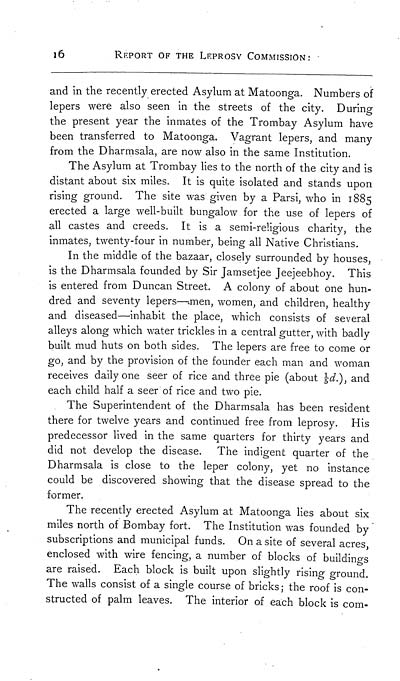Medicine - Disease > Leprosy in India: report of the Leprosy Commission in India, 1890-91
(65) Page 16
Download files
Individual page:
Thumbnail gallery: Grid view | List view

16 REPORT OF THE LEPROSY COMMISSION:
and in the recently erected Asylum at Matoonga. Numbers of
lepers were also seen in the streets of the city. During
the present year the inmates of the Trombay Asylum have
been transferred to Matoonga. Vagrant lepers, and many
from the Dharmsala, are now also in the same Institution.
The Asylum at Trombay lies to the north of the city and is
distant about six miles. It is quite isolated and stands upon
rising ground. The site was given by a Parsi, who in 1885
erected a large well-built bungalow for the use of lepers of
all castes and creeds. It is a semi-religious charity, the
inmates, twenty-four in number, being all Native Christians.
In the middle of the bazaar, closely surrounded by houses,
is the Dharmsala founded by Sir Jamsetjee Jeejeebhoy. This
is entered from Duncan Street. A colony of about one hun-
dred and seventy lepers-men, women, and children, healthy
and diseased-inhabit the place, which consists of several
alleys along which water trickles in a central gutter, with badly
built mud huts on both sides. The lepers are free to come or
go, and by the provision of the founder each man and woman
receives daily one seer of rice and three pie (about 1/5 d.), and
each child half a seer of rice and two pie.
The Superintendent of the Dharmsala has been resident
there for twelve years and continued free from leprosy. His
predecessor lived in the same quarters for thirty years and
did not develop the disease. The indigent quarter of the
Dharmsala is close to the leper colony, yet no instance
could be discovered showing that the disease spread to the
former.
The recently erected Asylum at Matoonga lies about six
miles north of Bombay fort. The Institution was founded by
subscriptions and municipal funds. On a site of several acres,
enclosed with wire fencing, a number of blocks of buildings
are raised. Each block is built upon slightly rising ground.
The walls consist of a single course of bricks; the roof is con-
structed of palm leaves. The interior of each block is com-
and in the recently erected Asylum at Matoonga. Numbers of
lepers were also seen in the streets of the city. During
the present year the inmates of the Trombay Asylum have
been transferred to Matoonga. Vagrant lepers, and many
from the Dharmsala, are now also in the same Institution.
The Asylum at Trombay lies to the north of the city and is
distant about six miles. It is quite isolated and stands upon
rising ground. The site was given by a Parsi, who in 1885
erected a large well-built bungalow for the use of lepers of
all castes and creeds. It is a semi-religious charity, the
inmates, twenty-four in number, being all Native Christians.
In the middle of the bazaar, closely surrounded by houses,
is the Dharmsala founded by Sir Jamsetjee Jeejeebhoy. This
is entered from Duncan Street. A colony of about one hun-
dred and seventy lepers-men, women, and children, healthy
and diseased-inhabit the place, which consists of several
alleys along which water trickles in a central gutter, with badly
built mud huts on both sides. The lepers are free to come or
go, and by the provision of the founder each man and woman
receives daily one seer of rice and three pie (about 1/5 d.), and
each child half a seer of rice and two pie.
The Superintendent of the Dharmsala has been resident
there for twelve years and continued free from leprosy. His
predecessor lived in the same quarters for thirty years and
did not develop the disease. The indigent quarter of the
Dharmsala is close to the leper colony, yet no instance
could be discovered showing that the disease spread to the
former.
The recently erected Asylum at Matoonga lies about six
miles north of Bombay fort. The Institution was founded by
subscriptions and municipal funds. On a site of several acres,
enclosed with wire fencing, a number of blocks of buildings
are raised. Each block is built upon slightly rising ground.
The walls consist of a single course of bricks; the roof is con-
structed of palm leaves. The interior of each block is com-
Set display mode to: Large image | Zoom image | Transcription
Images and transcriptions on this page, including medium image downloads, may be used under the Creative Commons Attribution 4.0 International Licence unless otherwise stated. ![]()
| India Papers > Medicine - Disease > Leprosy in India: report of the Leprosy Commission in India, 1890-91 > (65) Page 16 |
|---|
| Permanent URL | https://digital.nls.uk/74556288 |
|---|




